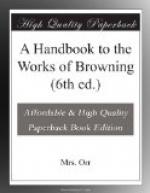Mr. Browning was, with his family, at Pornic many years ago, and there saw the gipsy who is the original of Fifine. His fancy was evidently sent roaming, by her audacity, her strength—the contrast which she presented to the more spiritual types of womanhood; and this contrast eventually found expression in a poetic theory of life, in which these opposite types and their corresponding modes of attraction became the necessary complement of each other. As he laid down the theory, Mr. Browning would be speaking in his own person. But he would turn into someone else in the act of working it out—for it insensibly carried with it a plea for yielding to those opposite attractions, not only successively, but at the same time; and a modified Don Juan would grow up under his pen, thinking in some degree his thoughts, using in some degree his language, and only standing out as a distinctive character at the end of the poem. The higher type of womanhood must appear in the story, at the same time as the lower which is represented by Fifine; and Mr. Browning would instinctively clothe it in the form which first suggested or emphasized the contrast. He would soon, however, feel that the vision was desecrated by the part it was called upon to play. He would disguise or ward it off when possible: now addressing Elvire by her husband’s mouth, in the terms of an ideal companionship, now again reducing her to the level of an every-day injured wife; and when the dramatic Don Juan was about to throw off the mask, the flickering wifely personality would be extinguished altogether, and the unfaithful husband left face to face with the mere phantom of conscience which, in one sense, Elvire is always felt to be. This is what actually occurs; and only from this point of view can we account for the perpetual encroaching of the imaginary on the real, the real on the imaginary, which characterizes the work.
A fanciful prologue, “Amphibian,” strikes its key-note. The writer imagines himself floating on the sea, pleasantly conscious of his bodily existence, yet feeling unfettered by it. A strange beautiful butterfly floats past him in the air; her radiant wings can be only those of a soul; and it strikes him that while the waves are his property, and the air is hers, hers is true freedom, his only the mimicry of it. He sees little to regret in this, since imagination is as good as reality; and Heaven itself can only be made up of such things as poets dream. Yet he knows that his swimming seems but a foolish compromise between the flight to which he cannot attain, and the more grovelling mode of being which he has no real wish to renounce; and he wonders whether she, the already released, who is upborne by those sunlit wings, does not look down with pity and wonder upon him. So also will Elvire, though less dispassionately, watch the intellectual vagaries of her Don Juan, which embrace the heavens, but are always centred in earth. This prologue is preceded by a quotation from Moliere’s “Don Juan,” in which Elvire satirically prescribes to her lover the kind of self-defence—or something not unlike it—which Mr. Browning’s hero will adopt.




